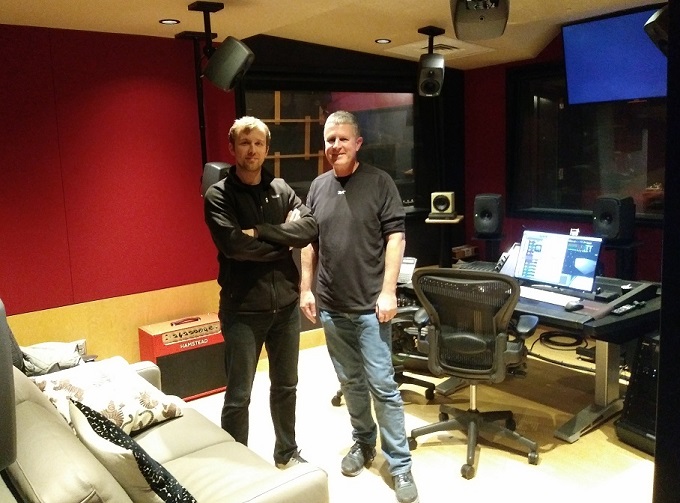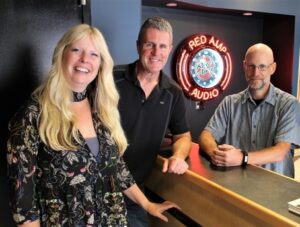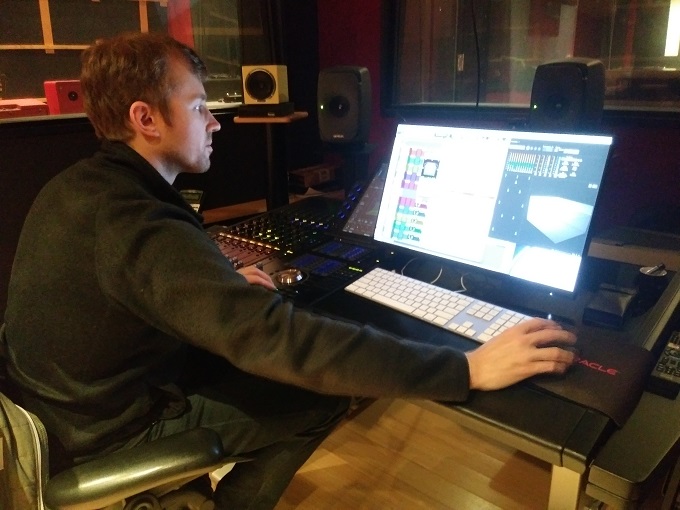
Andrew Uvarov, left, and Jody Boyd in Red Amp Audio’s Dolby Atmos-equipped studio. (Jonathan Spiers photos)
Know that surround-sound promo before the movies in certain theaters with that voice that whispers, “All…around…you”? Now, a Richmond recording studio is able to say the same thing.
Red Amp Audio has equipped its Grace Street facility with Dolby Atmos recording and audio mixing technology, making it the first commercial sound studio in Virginia to be Dolby-certified as an Atmos-capable studio.
Dolby Atmos is the latest surround-sound technology that goes beyond the five- and seven-speaker placements of Dolby Digital 5.1 and Dolby Surround 7.1 to include additional channels and spatial sound capabilities to create a more immersive sound experience.
Dolby Atmos (think atmosphere) has made its way into high-tech movie theaters and is becoming an industry standard in music and TV and more widespread with advances in digital audio/visual technologies.
While there are a few other Atmos-equipped recording rooms in Virginia – one at Shenandoah University in Winchester and another at MixStar Studios, a private facility in Virginia Beach – Red Amp’s is the first commercially bookable Atmos studio in the state, said Andrew Uvarov, an engineer and sound mixer at Red Amp.
Noting Shenandoah’s studio is an educational facility and MixStar’s is private, Uvarov said, “You can’t just go in there and knock on the door and start working on your project.”
When artists that Red Amp was working with started telling them about the technology, co-owner Jody Boyd said he put on some Apple headphones equipped with the technology, gave some Atmos-mixed recordings a listen, and got on board.
“I was like, wow, this is literally a new frontier, because sometimes the lead vocal would be in the center, sometimes it would be in stereo. Sometimes, in real modern pop mixes, it’s all over the place and they do all kinds of radical stuff with the mix,” Boyd said. “I got really excited about it then, and then all these same artists that were coming in here to record were like, ‘I’ve got this back catalog.’”
Remixing back catalogs, or artists’ previously recorded tracks, is one of the needs that Red Amp aims to meet with its new Atmos capabilities. Boyd said Apple Music offers artists more for Atmos mixes, giving artists an incentive to not only record with the technology but to revisit and remix their previous recordings.
“It’s a requirement now that you mix everything in Atmos for motion picture,” said Uvarov, a VCU alum and Latvia native. “In the past, you’d have to go to Nashville or New York or Los Angeles to do that, which is great. But it was like, why not have this in our town?”

Red Amp’s layout involves seven speakers on a horizontal plane, four overheads and one speaker for low frequency effect reproduction. (Red Amp Audio photo)
A Dolby crew installed the technology at Red Amp in August, and the studio announced the upgrade a month later, though Boyd and Uvarov said they’ve been slow to spread the word while getting up to speed with their new capability. Red Amp’s layout involves seven speakers on a horizontal plane, four overheads, and one speaker for low frequency effect reproduction.
“As we’re learning it, we’re trying to see what’s the best way we cannot draw attention to the technology but use it to put you in the song, to make you relate more to whatever the artist is trying to say,” Uvarov said.
Late last year, the studio was using the technology to record new songs with Charlottesville rock band Pale Blue Dot. Boyd, who co-owns Red Amp with spouse Marna Bales, said bookings for Atmos recordings were adding up heading into this year. Bales said details on those bookings could not be shared yet.
Red Amp’s rates for Atmos audio mixing per song run from $300 to $1,000, while its audio post-production rates with Atmos is determined per project, Bales said.
Its regular audio recording and post-production rates range from $200 to $350 per hour. The studio also offers podcast recording, with rates ranging from $50 an hour for a dedicated podcasting suite it established in 2018, to $125 an hour for podcast recording in the studio’s tracking room. Both podcasting rates have a two-hour minimum.
Boyd wouldn’t say how much Red Amp spent on the Atmos install, though he described the investment as “thousands” of dollars. He said the investment will be worth it.
“It’s worth the investment not only the fact that we’re starting to get work doing it, but the fact that it’s something new for Andrew and I to get into that keeps our interest piqued for continuing doing what we love to do,” he said.
Added Uvarov: “I think the streamers like Netflix, Hulu and Amazon will not accept your delivery if it’s not Atmos. Universal, Sony, BMG, all those music guys, they don’t accept your mixes unless it has an Atmos component, so the writing is kind of on the wall.
“Are we mixing the next U2 record? Probably not. But that’s not what we’re here for,” he said. “Just for us to be able to work in the technology that is the forefront of what ‘the big guys’ are doing, to be able to have all the local guys come in and try it out and see, that’s invaluable.”
Boyd said adding Atmos has been a natural progression with Red Amp’s core business shifting in recent years from primarily post-production to more music and audio recording work, a change he said came with the pandemic.
A musician for decades, Boyd said he liked the idea of the studio paying the bills and letting him keep playing music, though he said he and Bales initially questioned whether they should build a recording studio when audio post-production had been their bread and butter.

Boyd with Red Amp co-owner and wife Marna Bales and staffer Jay Smack in 2018. (BizSense file photo)
“At first we were like, ‘Should we build the music studio? I don’t know, because our audio post is paying the bills.’ And when Covid hit, it did a total turnaround, totally the other way. I was like, thank God we built a music studio. It was the smartest thing we ever did,” Boyd said.
“We’d always done a lot of music, but it seems like it just doubled after Covid, and it’s still going,” he said. “That was not what we expected when we started the business. I’m not complaining.”
Beyond music recording and mixing and audio post-production, Red Amp’s sound work ranges from TV and radio commercials to music composition, sound design and voice work for ads and motion pictures.
Founded in 2001, Red Amp has a staff of five and fills the bulk of the building at 9 W. Grace St., where the studio is set to get new neighbors in coming years with the planned redevelopment of the neighboring downtown YMCA building. The project from a team led by developer George Emerson includes new apartment buildings that would fill the parking lots on both sides of Red Amp.

Andrew Uvarov, left, and Jody Boyd in Red Amp Audio’s Dolby Atmos-equipped studio. (Jonathan Spiers photos)
Know that surround-sound promo before the movies in certain theaters with that voice that whispers, “All…around…you”? Now, a Richmond recording studio is able to say the same thing.
Red Amp Audio has equipped its Grace Street facility with Dolby Atmos recording and audio mixing technology, making it the first commercial sound studio in Virginia to be Dolby-certified as an Atmos-capable studio.
Dolby Atmos is the latest surround-sound technology that goes beyond the five- and seven-speaker placements of Dolby Digital 5.1 and Dolby Surround 7.1 to include additional channels and spatial sound capabilities to create a more immersive sound experience.
Dolby Atmos (think atmosphere) has made its way into high-tech movie theaters and is becoming an industry standard in music and TV and more widespread with advances in digital audio/visual technologies.
While there are a few other Atmos-equipped recording rooms in Virginia – one at Shenandoah University in Winchester and another at MixStar Studios, a private facility in Virginia Beach – Red Amp’s is the first commercially bookable Atmos studio in the state, said Andrew Uvarov, an engineer and sound mixer at Red Amp.
Noting Shenandoah’s studio is an educational facility and MixStar’s is private, Uvarov said, “You can’t just go in there and knock on the door and start working on your project.”
When artists that Red Amp was working with started telling them about the technology, co-owner Jody Boyd said he put on some Apple headphones equipped with the technology, gave some Atmos-mixed recordings a listen, and got on board.
“I was like, wow, this is literally a new frontier, because sometimes the lead vocal would be in the center, sometimes it would be in stereo. Sometimes, in real modern pop mixes, it’s all over the place and they do all kinds of radical stuff with the mix,” Boyd said. “I got really excited about it then, and then all these same artists that were coming in here to record were like, ‘I’ve got this back catalog.’”
Remixing back catalogs, or artists’ previously recorded tracks, is one of the needs that Red Amp aims to meet with its new Atmos capabilities. Boyd said Apple Music offers artists more for Atmos mixes, giving artists an incentive to not only record with the technology but to revisit and remix their previous recordings.
“It’s a requirement now that you mix everything in Atmos for motion picture,” said Uvarov, a VCU alum and Latvia native. “In the past, you’d have to go to Nashville or New York or Los Angeles to do that, which is great. But it was like, why not have this in our town?”

Red Amp’s layout involves seven speakers on a horizontal plane, four overheads and one speaker for low frequency effect reproduction. (Red Amp Audio photo)
A Dolby crew installed the technology at Red Amp in August, and the studio announced the upgrade a month later, though Boyd and Uvarov said they’ve been slow to spread the word while getting up to speed with their new capability. Red Amp’s layout involves seven speakers on a horizontal plane, four overheads, and one speaker for low frequency effect reproduction.
“As we’re learning it, we’re trying to see what’s the best way we cannot draw attention to the technology but use it to put you in the song, to make you relate more to whatever the artist is trying to say,” Uvarov said.
Late last year, the studio was using the technology to record new songs with Charlottesville rock band Pale Blue Dot. Boyd, who co-owns Red Amp with spouse Marna Bales, said bookings for Atmos recordings were adding up heading into this year. Bales said details on those bookings could not be shared yet.
Red Amp’s rates for Atmos audio mixing per song run from $300 to $1,000, while its audio post-production rates with Atmos is determined per project, Bales said.
Its regular audio recording and post-production rates range from $200 to $350 per hour. The studio also offers podcast recording, with rates ranging from $50 an hour for a dedicated podcasting suite it established in 2018, to $125 an hour for podcast recording in the studio’s tracking room. Both podcasting rates have a two-hour minimum.
Boyd wouldn’t say how much Red Amp spent on the Atmos install, though he described the investment as “thousands” of dollars. He said the investment will be worth it.
“It’s worth the investment not only the fact that we’re starting to get work doing it, but the fact that it’s something new for Andrew and I to get into that keeps our interest piqued for continuing doing what we love to do,” he said.
Added Uvarov: “I think the streamers like Netflix, Hulu and Amazon will not accept your delivery if it’s not Atmos. Universal, Sony, BMG, all those music guys, they don’t accept your mixes unless it has an Atmos component, so the writing is kind of on the wall.
“Are we mixing the next U2 record? Probably not. But that’s not what we’re here for,” he said. “Just for us to be able to work in the technology that is the forefront of what ‘the big guys’ are doing, to be able to have all the local guys come in and try it out and see, that’s invaluable.”
Boyd said adding Atmos has been a natural progression with Red Amp’s core business shifting in recent years from primarily post-production to more music and audio recording work, a change he said came with the pandemic.
A musician for decades, Boyd said he liked the idea of the studio paying the bills and letting him keep playing music, though he said he and Bales initially questioned whether they should build a recording studio when audio post-production had been their bread and butter.

Boyd with Red Amp co-owner and wife Marna Bales and staffer Jay Smack in 2018. (BizSense file photo)
“At first we were like, ‘Should we build the music studio? I don’t know, because our audio post is paying the bills.’ And when Covid hit, it did a total turnaround, totally the other way. I was like, thank God we built a music studio. It was the smartest thing we ever did,” Boyd said.
“We’d always done a lot of music, but it seems like it just doubled after Covid, and it’s still going,” he said. “That was not what we expected when we started the business. I’m not complaining.”
Beyond music recording and mixing and audio post-production, Red Amp’s sound work ranges from TV and radio commercials to music composition, sound design and voice work for ads and motion pictures.
Founded in 2001, Red Amp has a staff of five and fills the bulk of the building at 9 W. Grace St., where the studio is set to get new neighbors in coming years with the planned redevelopment of the neighboring downtown YMCA building. The project from a team led by developer George Emerson includes new apartment buildings that would fill the parking lots on both sides of Red Amp.




Cool.